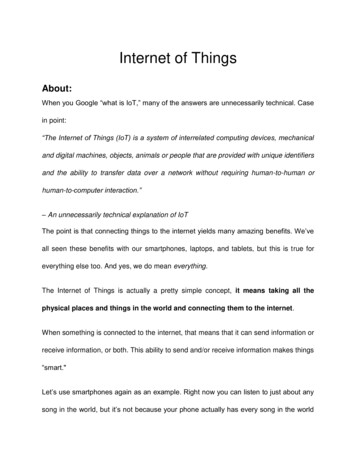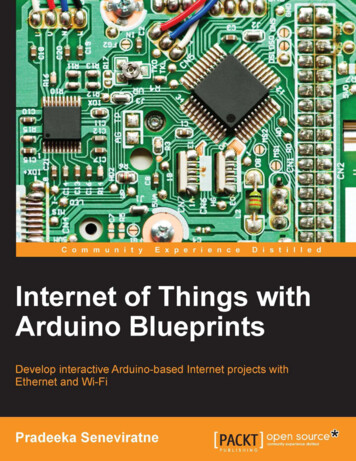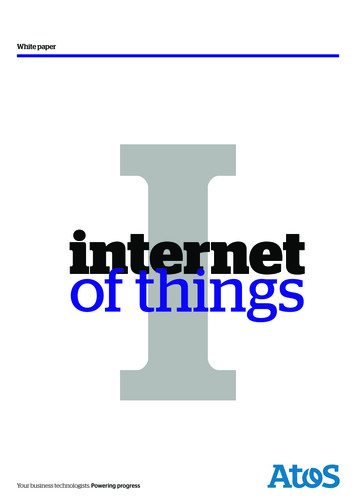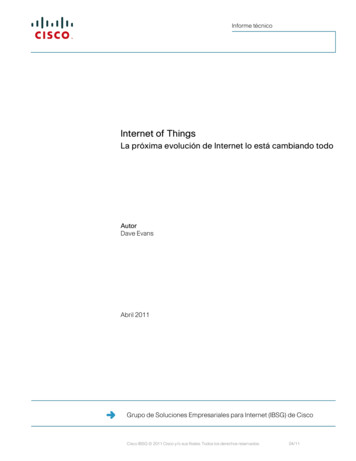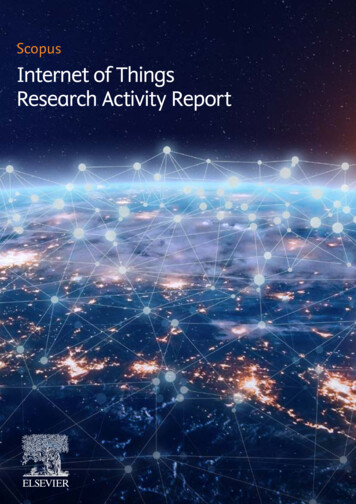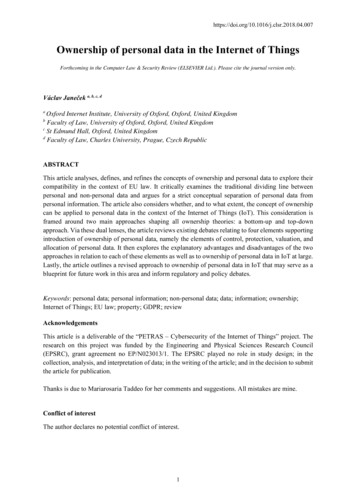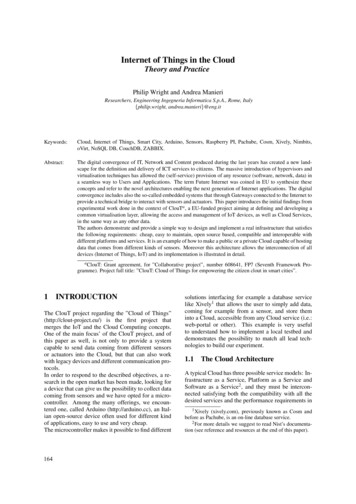
Transcription
Internet of Things in the CloudTheory and PracticePhilip Wright and Andrea ManieriResearchers, Engineering Ingegneria Informatica S.p.A., Rome, Italy{philip.wright, andrea.manieri}@eng.itKeywords:Cloud, Internet of Things, Smart City, Arduino, Sensors, Raspberry PI, Pachube, Cosm, Xively, Nimbits,oVirt, NoSQL DB, CouchDB, ZABBIX.Abstract:The digital convergence of IT, Network and Content produced during the last years has created a new landscape for the definition and delivery of ICT services to citizens. The massive introduction of hypervisors andvirtualisation techniques has allowed the (self-service) provision of any resource (software, network, data) ina seamless way to Users and Applications. The term Future Internet was coined in EU to synthesize theseconcepts and refer to the novel architectures enabling the next generation of Internet applications. The digitalconvergence includes also the so-called embedded systems that through Gateways connected to the Internet toprovide a technical bridge to interact with sensors and actuators. This paper introduces the initial findings fromexperimental work done in the context of ClouTa , a EU-funded project aiming at defining and developing acommon virtualisation layer, allowing the access and management of IoT devices, as well as Cloud Services,in the same way as any other data.The authors demonstrate and provide a simple way to design and implement a real infrastructure that satisfiesthe following requirements: cheap, easy to maintain, open source based, compatible and interoperable withdifferent platforms and services. It is an example of how to make a public or a private Cloud capable of hostingdata that comes from different kinds of sensors. Moreover this architecture allows the interconnection of alldevices (Internet of Things, IoT) and its implementation is illustrated in detail.a ClouT: Grant agreement, for ”Collaborative project”, number 608641, FP7 (Seventh Framework Programme). Project full title: ”ClouT: Cloud of Things for empowering the citizen clout in smart cities”.1INTRODUCTIONThe ClouT project regarding the ”Cloud of Things”(http://clout-project.eu/) is the first project thatmerges the IoT and the Cloud Computing concepts.One of the main focus’ of the ClouT project, and ofthis paper as well, is not only to provide a systemcapable to send data coming from different sensorsor actuators into the Cloud, but that can also workwith legacy devices and different communication protocols.In order to respond to the described objectives, a research in the open market has been made, looking fora device that can give us the possibility to collect datacoming from sensors and we have opted for a microcontroller. Among the many offerings, we encountered one, called Arduino (http://arduino.cc), an Italian open-source device often used for different kindof applications, easy to use and very cheap.The microcontroller makes it possible to find different164solutions interfacing for example a database servicelike Xively1 that allows the user to simply add data,coming for example from a sensor, and store theminto a Cloud, accessible from any Cloud service (i.e.:web-portal or other). This example is very usefulto understand how to implement a local testbed anddemonstrates the possibility to match all lead technologies to build our experiment.1.1The Cloud ArchitectureA typical Cloud has three possible service models: Infrastructure as a Service, Platform as a Service andSoftware as a Service2 , and they must be interconnected satisfying both the compatibility with all thedesired services and the performance requirements in1 Xively(xively.com), previously known as Cosm andbefore as Pachube, is an on-line database service.2 For more details we suggest to read Nist’s documentation (see reference and resources at the end of this paper).
Internet of Things in the Cloud - Theory and Practicea big data environment.In particular, the software that will be deployed in orconsumed from the Cloud must be compatible withthe most used operating systems and devices; it mustbe user friendly and stable. The Platform tools andmiddleware must be engineered to have the best performance when receiving and storing huge amountsof data. The Infrastructure must also be stable, easyto maintain, and through with future implementationsin mind. Last, but not least, security is an importantissue for all the three mentioned service models of theCloud, even though it will not be thoroughly coveredin this paper.2STATE OF THE ART AND THEClouT APPROACHThe first step approached in the ClouT project hasbeen to analyse all the solutions available in commerce that respond to the project requirements. Thesecond step was to build a case study based on capturing information from a temperature sensor; throughthe Arduino device. In fact it was tested and selectedalso because there are many different Cloud providerscompatible with it, allowing to use a web page to storeand read data, and the implementation just requiresmodifying few lines of code.In building the prototype, confirmation was receivedthat Arduino is indeed friendly and useful for the purposes of the experiment.Below an analysis of the components and the technology that were planned to be used in the first phase.2.1Figure 1: Arduino (Simple schema).Figure 2: Sensor-Arduino-Xively.2.2XivelyXively is a public Cloud for the Internet of Things thatpermits to connect different private or public deviceslike Arduino with dedicated API keys, in order to allow the user to put and get the data coming from adevice, and have simple access to it from the websitewith a smartphone, a tablet or a computer, as shownin Fig.3 below.ArduinoArduino is an open-source electronics prototypingplatform, available to create interactive objects or environments, easy to use (hardware and software), asshown in a simple schema in Fig.1. The microcontroller on the board must be programmed using itsown language that allows the developer, for example,to read a value coming from a sensor in a specific timeinterval.Arduino projects can be stand-alone or can communicate with software on a computer; in this case astand-alone project with a dedicated Arduino’s Ethernet Shield, which allows networking, was opted formaking outgoing connections to a dedicated storagefor the data coming from the sensor; in this way, forthis case study, an Ethernet Shield and the chosen sensor was needed to be connected to the Arduino (SeeFig.2 below).Figure 3: Xively (an example of visualization of the datasent).To carry out the example mentioned before, it isonly needed to: sign in on the Xively website, adda new project, specify the utilization of the Arduino,save the received APIKEY and FEEDID keys, andmodify the example code on the ”File - Example Ethernet - Pachube Client”3 .3 Example of the Arduino program for a simple accessdata to the Cloud, created on 15 March 2010, modified on 9Apr 2012 by Tom Igoe with input from Usman Haque andJoe Saavedra, http://arduino.cc/en/Tutorial/PachubeClient;this code is in the public domain.165
CLOSER 2014 - 4th International Conference on Cloud Computing and Services Science2.3NimbitsLike Xively there is also Nimbits made by Google;both can be used to collect data, because they are allbased on the same structure and logic: the data coming from the sensor are all processed, and then sentto the Cloud’s services through SQL. The data arecollected into a storage, through a web page and afterwards they can be visualized on a thin (tablet orsmartphone) or thick (PC) client.2.4Raspberry PiSimilar to Arduino, as well, it is also available anopen-source device named Raspberry Pi, that can connect and use both Xively and Nimbits services. Inorder to use it, an Operating System (OS)4 must beinstalled onto an SD card. In that sense RaspberryPi represents a real microcomputer while Arduino isa microcontroller; this characteristics gives the possibility to use both the devices.2.5Raspberry Pi and ArduinoThe possibility of connecting the two devices and ofinstalling the Arduino software tools inside the Raspberry Pi, can solve an important management issuerepresented for instance by the remote update of thedistributed Arduino devices. In fact, as more thenone Arduino microcontroller can be connected to oneRaspberry Pi microcomputer, it is possible to modify its configuration through internet, i.e. without anycable connection. Others interesting solutions can beadded like, for example, storing the data locally, remote monitoring of the hardware status and performance, changing the interval of data acquisition, andso on.The Arduino and the Raspberry Pi devices can easily communicate with each other in different ways:they can communicate through Ethernet, Bluetooth orWireless communication, but it is also possible to theRaspberry Pi to use an Arduino Shield, or just convertthe I/O pin tension5 .2.6Raspberry Pi as a Data StorageAn interesting aspect could be to make the RaspberryPi device such as to behave like a server and data storage, installing on it a NoSQL DB, like CouchDB, andconnect it to the Arduino on internet; in this way one4 RaspberryPi can be operated by an optimised LinuxOS chosen among list.5 Arduino needs 5V instead of Raspberry Pi 3.3V, therespective Pins must be connected.166obtains a real ”Internet of Things” communication.However we have to consider that such configurationdoes not provide a real Cloud service, like, for example, an Infrastructure as a Service model may. Therefore we have discarded this hypothesis, because themain object of the project is ”infinity processing andstorage capacity of data from trillions of things andpeople that are integrated via virtual services in theCloud”; for this reason, we will employ a Virtual Machine (VM) running inside a private Cloud. The mentioned ability of the Raspberry Pi to store a limitedamount of data could be useful for backup functionsin case of a short interruption of the communicationbetween the device and the VM.3MANAGING DATA STORAGEIN A NoSQL DBThis chapter described a practical example of how tomake a real Infrastructure as a Service, and how touse it.Among the different open-source solutions, it hasbeen chosen and tested one that appeared to be one themost interesting: oVirt. It is an open-source Infrastructure as a Service solution that allows the client, using an interface (the oVirt engine, see Fig.4), to manage hardware nodes, storage and network resources,and to deploy and monitor virtual machines runningon the data center.Given that the main strength of the Cloud approach isin the optimisation of the hardware resources throughvirtualisation, enabling a meaningful cut on total costsof ownership, we decided to choose a VM, instead ofa simple dedicated machine, as a server. Another really useful and powerful Cloud oriented virtualisationsolution that we considered was OpenStack, but in ourtest case oVirt was fit for the task.It is possible to manage your own VMs using oVirt,simply accessing a web interface known as User Portal (see Fig.4).oVirt provides a high availability mechanism that permits the automatic migration of a VM to another hardware node in case of failure on the current hostingnode. That happens without losing any data or information, and no manual action on the VM is needed.In our test case we employed a VM with CentOS6.4 as OS and CouchDB installed as database to storedata; in this way it is possible to send a string throughTCP/IP and store data on the NoSQL DB (in this caseCouchDB). For performance reasons it is highly recommended to store data this way, and not, for example, to employ a mySql DB, especially since a ”terabyte torrent” coming from trillions of devices is ex-
Internet of Things in the Cloud - Theory and Practice4Figure 4: oVirt Engine.pected. Once CouchDB is installed it is possible tohave an idea on how to read and manage the data accessing an URL like: http://VM ADDRESS:5984/utils/index.html, where WM ADDRESS is the IPADDRESS of the VM previously made. To providea unified way to access and store data we choose theCDMI standard, that offers a standard data interfaceinstalled in the Cloud. In our case we prefer to use asoftware called CDMI-Proxy.Whatever the solution chosen, CouchDB or CDMIProxy, it is only needed to modify the sample code created for the Arduino to communicate with Xively, previously created6 , changing theserver name, instead of ”api.pachube.com”, insert”your.VM.host.name”, and specify port number 5984if using CouchDB; otherwise, if you use CDMIProxy, insert port 8080 or 23657 . In addition, fewcode lines must be modified in the main sendDatafunction, because CoachDB follows the JSON format(see official website guide for the format to use)8 .At this point all the data, that has been automaticallystored in the chosen DB, must be read. In order todo this, we have evaluated a well-known and standardprocedure based on a web server package like httpd.In this case it requires a workload to carry out ”manually”, therefore there is a risk of making mistakes andreduces the security. Therefore, we examined otherpossibilities, with the aim of finding a solution thatis still based on an open-source system, but is easierto implement and maintain, and, lastly, is more stable and efficient. ZABBIX, seems to respond to theabove mentioned requirements.6 Seeparagraph on Xivelyone of these two ports (8080/2365), instead ofthe standard CouchDB port is useful for security reasons,but it is not enough to be safe from packet sniffing. In thiscase using SSL protocol to encrypt data is recommended.8 (These conclusions, regarding the infrastructure side ofhow to use a NoSQL DB, need additional work on the platform side of the Cloud. Such work will be one of our nexttasks.)7 UsingMONITORING WITH ZABBIXAll signals, coming from the variety of sensors installed in many different locations, must be captured,analysed, stored and represented in a quite understandable form and possibly, in case of alarms, inreal time. It would be interesting, and quite usefulfor our purposes, if there is the possibility to controland monitor in real time all the items previously mentioned using a software available in the open sourcemarket. Therefore we have tested some solutions andfinally found one, named ZABBIX, that can carry outthe needed controls. It consists of two different elements in connection: the agent and the server. If,for example, we want to control all the sensors witha device like Arduino, and we want to connect moreof these devices to only one microcomputer, that inour test is a Raspberry Pi, it sufficient to install ZABBIX agent on the Raspberry Pi and ZABBIX serveron a Virtual Machine. The agent sends all the data tothe ZABBIX server so that the data can be not onlystored, but also shown on a map and monitored in avery easy way. In a test we made, the informationshown was an alarm for an exceptional high temperature captured by some sensors connected to one of thedevices.The monitoring options can be added during the firstinstallation, but they can be also modified later, remotely, by an administrator who can also add moreusers having each one different powers of access tothe system. This feature allows not only the simple monitoring of the sensors, but also of the devicesused, the Virtual Machine, the Raspberry Pi and allthe network connected, as it is shown in the enclosedfig.5.Figure 5: A screen of a web page interface of ZABBIXserver running on Engineering’s VM.In Fig.5 there is also an actuator, which will bestudied in the next ClouT project phases.Another example of the data coming from a sensoris in Fig.6, where no filter was applied, and for thisreason there are different range of values in spite of a167
CLOSER 2014 - 4th International Conference on Cloud Computing and Services Sciencesmall time interval. The continue line is because theRaspberry Pi and the Arduino were connected, but,after some time, we manually stopped the code running on the Raspberry Pi.Figure 6: An example of a temperature graph of data coming from a sensor.5POSSIBLE APPLICATIONSFOR SMART CITIESThe ClouT project aims at empowering the citizenclout in smart cities.What has been designed so far in the course of theproject, and here briefly described, can cover many ofthe different features that are now included in what iscalled a Smart City. Reference is made to the possibility of collecting data, producing statistics, monitoring services, etc. and, for example, two applicationsaimed at improving the citizen’s quality of life. Allthis is obtained by capturing data from many sensorsand devices positioned in different places and eachone devoted to a specific function. One applicationdrafted regarded an intelligent fire alarm system, involving temperature sensors and web cams automatically switching on, in case of rapidly rising temperatures, and sending images of the scene to a commandand control center or to supervisor, on his smartphone.Another example of a possible and not expensiveapplications using the devices described in this paper,we can cite for instance the monitoring of people inflows and outflows from a room (i.e.: for security purposes or marketing), or, the presence of persons closeto a particular area of a hall and the duration of theirpresence (i.e.: for marketing purposes; cultural purposes; etc.). Such data, can be easily provided also intime series format, with statistics and graphs.The two applications have required an in-depth studyand implementation, to simulate different situations,to detect all the problems that may occur, and, to makethe application completely automatic.The interesting feature, in our opinion, is that inusing the suggested hardware, configuration and connections between the different technologies, it means168to create the Internet of Things. The benefits of CloudComputing are that the end users need not worryabout the exact location of servers and they can switchto their application by connecting to the server onCloud and start working without any trouble and noinstallation is required: just an internet connectionand the right credentials. All the data are stored on adedicated database, that permits big data storage, likethe Cloud Platform allows.Several other applications may be conceived toempower the citizens in smart cities: to improve mobility, to help social services, to save energy, etc.6CONCLUSION AND NEXTSTEPSAs we wrote on the first chapter of this document,the first step we approached in the ClouT project wasto analyse all the things previously implemented andexisting in commerce. We started using open-sourcetechnology, hardware and software, because they arecheap and can be used for different purposes; but thisdocument wants to be useful also using other similartechnology, because it wants to be as general as possible. Our idea on using a gateway or a little device tocontrol all the microcontrollers that collect data fromdifferent kind of sensors, makes it easy to control andto monitor the system as we can see on fig. 7.Figure 7: An example on the monitoring of the hardwareused.All the technologies used are already existing, butall their functions are not used at all.The prototype we have implemented, has also givenus the opportunity to understand that the infrastructure can be applied for the production of applicationsin domotics, medical environment, etc. In addition,the prototype showed us that it can manage a largemultitude of sensors, like those obtained from social
Internet of Things in the Cloud - Theory and Practicenetwork. Another possibility that came out during ourexperiments is that the Arduino device has demonstrated its ability to read sensors data in real time,while the Raspberry Pi device has greater potentialities because it hosts an operating system. Such features can be used to manage and update the softwarein a high number of distributed Arduino devices.Therefore both devices can provide a useful tool forfuture implementations.In conclusion, the project is still in the first phases,but since now a new and ample number of applications can be defined and implemented, on the basis ofthe described architecture.ACKNOWLEDGEMENTSSpecial thanks to our colleagues Marco EmanuelPalazzotti and Daniele Pavia for their contribution.REFERENCESArduino, official website, http://www.arduino.cc.M. Banzi (2011),”Getting Started with Arduino”,O’REILLY.Nist,National Institute of Standards and Technology, http://csrc.nist.gov/publications/ nistpubs/800145/SP800-145.pdf.Snia, Cloud Data Management Interface (CDMI), http://cdmi.sniacloud.com/.CDMI-Proxyprovides CDMI-compliant proxyserver to public cloud backends,https://github.com/livenson/vcdm.C. Pfister (2011), ”Getting Started with the Internet ofThings”, O’REILLY.Cosm, official website, http://www.xively.com.Raspberry Pi, official website, http://www.raspberrypi.org.Nimbits, official website, http://www.nimbits.com.oVirt, official website, http://www.oVirt.org.CouchDB, official website, http://couchdb.apache.org/.Zabbix, official website, http://www.zabbix.com/.OpenStack, official website documentation, http://docs.openstack.org.IoT-A, Internet of Things Architecture, http://www.iota.eu/public.C. Doukas (2012), ”Building Internet of Things with theArduino”.K. Ashton (2011), ”That ’Internet of Things’ Thing”. RfiDJournal.ZigBee,as a 6LoWPAN, low power wireless, IEEE802.15.4, http://www.zigbee.org/Standards/ ZigBeeNetworkDevices/Overview.aspx.T. Igoe (2011), ”Making Things Talk”. O’REILLY.169
oVirt, NoSQL DB, CouchDB, ZABBIX. Abstract: The digital convergence of IT, Network and Content produced during the last years has created a new land- . and to deploy and monitor virtual machines running on the data center. Given that the main strength of the Cloud approach is in the optimisation of the hardware resources through



